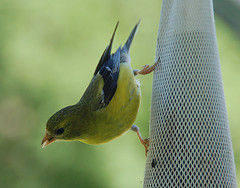Adaptation
 The
hot peppers are an angiosperm, which means that they have
vessels to transport water throughout the plant instead of
tracheids like the gymnosperms.
For an example of another angio
The
hot peppers are an angiosperm, which means that they have
vessels to transport water throughout the plant instead of
tracheids like the gymnosperms.
For an example of another angio sperm, click
here!
sperm, click
here!
Vessels are a much more efficient way to transport water than tracheids. Angiosperms are also deciduous, which means they lose all their leaves at once, or in the case of the hot pepper, die annually.
Being deciduous protects hot peppers against cold and snow. The ovary wall in a carpel
protects the ovules (seeds) in an angiosperm. Think of an orange
cut in half; every little triangular compartment you see in the orange is a
carpel. While we're on the topic of oranges, why not check them out
here! These triangular carpels become the fruit , or in the case of the
hot pepper, the pepper itself. This also makes them resistant to
drought and cold because the seeds are protected inside the
fruit.
, or in the case of the
hot pepper, the pepper itself. This also makes them resistant to
drought and cold because the seeds are protected inside the
fruit.
An interesting theory is that the hot peppers adapted the
capsaicin because it didn't affect birds. This would mean that
hot peppe rs evolved around what the birds were doing! The hot
pepper is brightly colored, suggesting that it wanted to attract
animals, but at the same time it has the awful spice to it,
suggesting that it wanted to keep animals at bay. Birds are not
affected by the capsaicin, so they are attracted by the brightly
colored hot pepper, and not turned away by the intense spice it
produces. There will be more on this subject later on in the
Interactions, but don't get ahead
of yourself! There is still plenty to learn about how hot
peppers get all of the Nutrients
they need to survive.
rs evolved around what the birds were doing! The hot
pepper is brightly colored, suggesting that it wanted to attract
animals, but at the same time it has the awful spice to it,
suggesting that it wanted to keep animals at bay. Birds are not
affected by the capsaicin, so they are attracted by the brightly
colored hot pepper, and not turned away by the intense spice it
produces. There will be more on this subject later on in the
Interactions, but don't get ahead
of yourself! There is still plenty to learn about how hot
peppers get all of the Nutrients
they need to survive.
